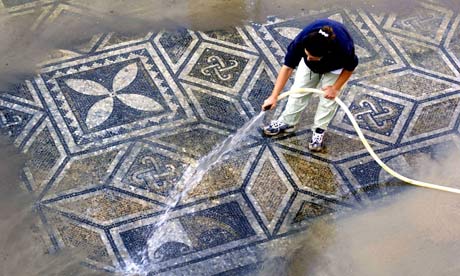Roman remains at risk from Turkey's dam building
Conservationists argue that development of archeological site would be more beneficial than irrigation plans

Several metres of sand now cover the second-century Roman baths at Allianoi, the largest in Asia Minor. The wall paintings and columns, a few kilometres from the ancient city of Pergamon in western Turkey, have been buried and may soon be submerged beneath 17 metres of water.
"It has become a political issue and the government is trying to get rid of Allianoi. We want to avoid a massacre," said Güven Eken, head of the Doga Dernegi conservation group. Last month Eken and a handful of activists chained themselves to the cranes on the construction site to draw attention to "a massacre of nature and a violation of the law".
Protesters say the layer of sand, which is supposed to protect the ruins, is ill-suited to the job, and cement containing brick dust is being used. The feasibility of the project itself, which involves building a dam and reservoir for irrigation of local farms, is open to doubt. "The river has run completely dry," Eken said, "and there is no certainty there will be enough water to fill the reservoir."
He added: "The government refuses to admit that Allianoi is an exceptional site and that the problem of water for farmers can be solved without wrecking our heritage."
The Yortanli scheme, started 15 years ago, disregards Turkish law on the protection of natural and historic heritage. A dozen or so court rulings have already sought to stop construction. The Allianoi ruins, if properly exploited, could have attracted hundreds of thousands of visitors every year.
The minister of culture and tourism, Ertugrul Günay, said that alarmist calls to save the ruins were "exaggerated". He maintained that the historic heritage would not be damaged in any way by the work. His counterpart at the environment ministry, Veysel Eroglu, was less diplomatic in his treatment of the popular singer Tarkan, who campaigned to save the Roman baths. "He shouldn't poke his nose into issues he doesn't understand," Eroglu said.
"Allianoi is being sacrificed for the sake of Eroglu's policies," Eken said, drawing attention to the many conflicts of interest involved. The minister, previously head of the state hydraulic works, which is responsible for supervising dam building, has launched a large number of irrigation and hydroelectric power projects since his appointment in 2007. Another reservoir, to be built on the Tigris at Ilisu in south-east Turkey, has stirred up wide opposition. It threatens to engulf the ancient town of Hasankeyf.
This article originally appeared in Le Monde
No comments:
Post a Comment